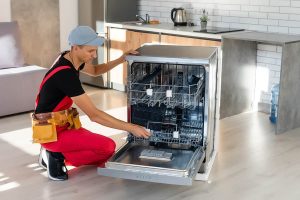A freestanding dishwasher is a convenient appliance to have in any modern kitchen. It saves you time and effort by automatically cleaning your dishes. Installing a freestanding dishwasher is relatively easy and requires a few basic tools. In this article, we will guide you through the step-by-step process of installing a freestanding dishwasher in your kitchen.

Before we begin, make sure you have the following tools and equipment:
- Phillips head screwdriver
- Adjustable wrench
- Pliers
- Measuring tape
- Dishwasher installation kit
- Electrical wire stripper
Step 1: Prepare the Space
The first step is to prepare the space where you want to install the dishwasher. Make sure that there is enough space to accommodate the dishwasher and that the flooring is level. Also, ensure that you have the necessary connections, such as a water supply and a drain.
Step 2: Measure and Cut the Supply Lines
Before you install the dishwasher, you need to measure and cut the supply lines for the water supply. You will need to connect the dishwasher to a hot water supply, so make sure that the water supply valve is turned off before you start.
Using a measuring tape, measure the distance between the hot water supply valve and the inlet valve on the dishwasher. Then, cut the copper supply line to the appropriate length using a pipe cutter. Make sure to remove any burrs or rough edges from the cut.
Step 3: Install the Water Supply Line
Next, you will need to install the water supply line. Attach the copper supply line to the hot water supply valve using a compression fitting. Tighten the compression fitting with an adjustable wrench. Then, attach the other end of the supply line to the inlet valve on the dishwasher. Tighten the nut with pliers, making sure not to over-tighten.
Step 4: Connect the Drain Hose
Once the water supply line is connected, it’s time to connect the drain hose. The drain hose is typically located at the back of the dishwasher. Connect the hose to the dishwasher by sliding the hose clamp over the end of the hose and pushing it onto the dishwasher’s drain outlet. Tighten the hose clamp with pliers.
Step 5: Level the Dishwasher
Before you can install the dishwasher, you need to level it. Use a level to ensure that the dishwasher is level in both directions. Adjust the dishwasher’s feet as necessary to level it.
Step 6: Connect the Electrical Wiring
The next step is to connect the electrical wiring. Before you begin, make sure that the dishwasher is turned off and that the electrical circuit is also turned off. Remove the cover plate on the bottom of the dishwasher to access the wiring.
Strip the electrical wires and connect the wires from the dishwasher to the wires from the electrical circuit using wire nuts. Make sure to connect the black wire to the black wire, the white wire to the white wire, and the green or bare wire to the ground wire.
Step 7: Slide the Dishwasher Into Place
Once the water supply line, drain hose, and electrical wiring are connected, slide the dishwasher into place. Make sure that the dishwasher is flush with the countertop and cabinets.
Step 8: Secure the Dishwasher
After you have slid the dishwasher into place, secure it to the countertop using screws. Use a Phillips head screwdriver to screw the mounting brackets to the underside of the countertop.
Step 9: Turn On the Water and Electrical Circuit
Now that the dishwasher is installed and secured, it’s time to turn on the water supply and the electrical circuit. Turn on the hot water supply valve and check for any leaks. Then, turn on the electrical circuit and test the dishwasher.
Unsure about installing a freestanding dishwasher & how to go about it?
Don’t take the risk of doing it yourself and potentially damaging your machine or your kitchen. Instead, consider working with professional plumbers who specialise in dishwasher installation. They have the knowledge and experience to handle this task with ease, ensuring your dishwasher is installed correctly and efficiently. Not only that, but they can also assist with other plumbing needs, from heat pump installation to troubleshooting leaks. Don’t get stuck in a mess – contact the experts today!




